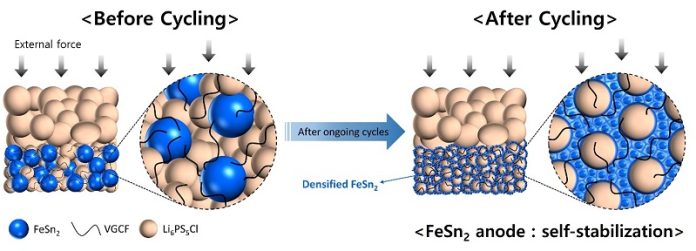
Researchers in South Korea have made an important discovery that could change the future of solid-state batteries (SSBs).
These new batteries are designed to be safer and more efficient than traditional ones.
The team, from the Korea Electrotechnology Research Institute (KERI), Kumoh National Institute of Technology, and Inha University, introduced a tin (Sn)-based alloy anode material that could offer big improvements.
Solid-state batteries (SSBs) use a solid electrolyte instead of the more common liquid electrolyte.
This makes them much safer because it significantly reduces the risk of fire or explosion. However, SSBs need advanced technology to ensure they stay stable during charging and discharging.
In these batteries, choosing the right anode material is critical, as it greatly affects charging speed and battery life.
Currently, most research focuses on using lithium (Li) metal as the anode in SSBs. While lithium-metal anodes work well, they have a major flaw: as they charge and discharge repeatedly, tiny structures called dendrites can form on their surface.
These dendrites grow like branches and can eventually cause a short circuit inside the battery, reducing its life and making it unsafe.
Some scientists have also explored using silicon anodes, but these come with their own problems. Silicon expands during charging, causing cracks in the material and leading to poor performance over time.
The researchers at KERI and their university partners found a promising alternative in a tin-based alloy called FeSn2.
After detailed analysis, they discovered that FeSn2 maintains good contact between its solid particles even after repeated charging and discharging cycles. This is crucial for keeping the battery stable and crack-free.
Moreover, the FeSn2 material showed high flexibility and resistance to damage, making it an excellent choice for long-term battery stability.
To test this new material, the team built a full SSB cell using a FeSn2 anode, an NCM622 cathode (a combination of nickel, cobalt, and manganese), and a sulfide solid electrolyte. The results were impressive: the new battery achieved an areal capacity five times higher than traditional lithium-ion batteries.
Additionally, it maintained over 70% capacity after 1,000 charging cycles, even when charged quickly in three or six minutes.
The researchers also created a prototype pouch cell using the FeSn2 anode, which showed a high energy density of more than 255 Wh/kg. This means the new anode material could help create batteries that last longer and store more energy, while also being safer.
Yoon-Cheol Ha, Director of KERI’s Next Generation Battery Research Center, emphasized the importance of this breakthrough.
“We’ve moved away from focusing only on lithium and silicon anodes and shown the great potential of tin-based alloys,” he said. Professor Cheol-Min Park from Kumoh National Institute added, “Our goal is to help commercialize these safer, high-performance solid-state batteries.”
This discovery could open the door to more reliable, long-lasting, and safer batteries in the near future.
Source: KSR.



